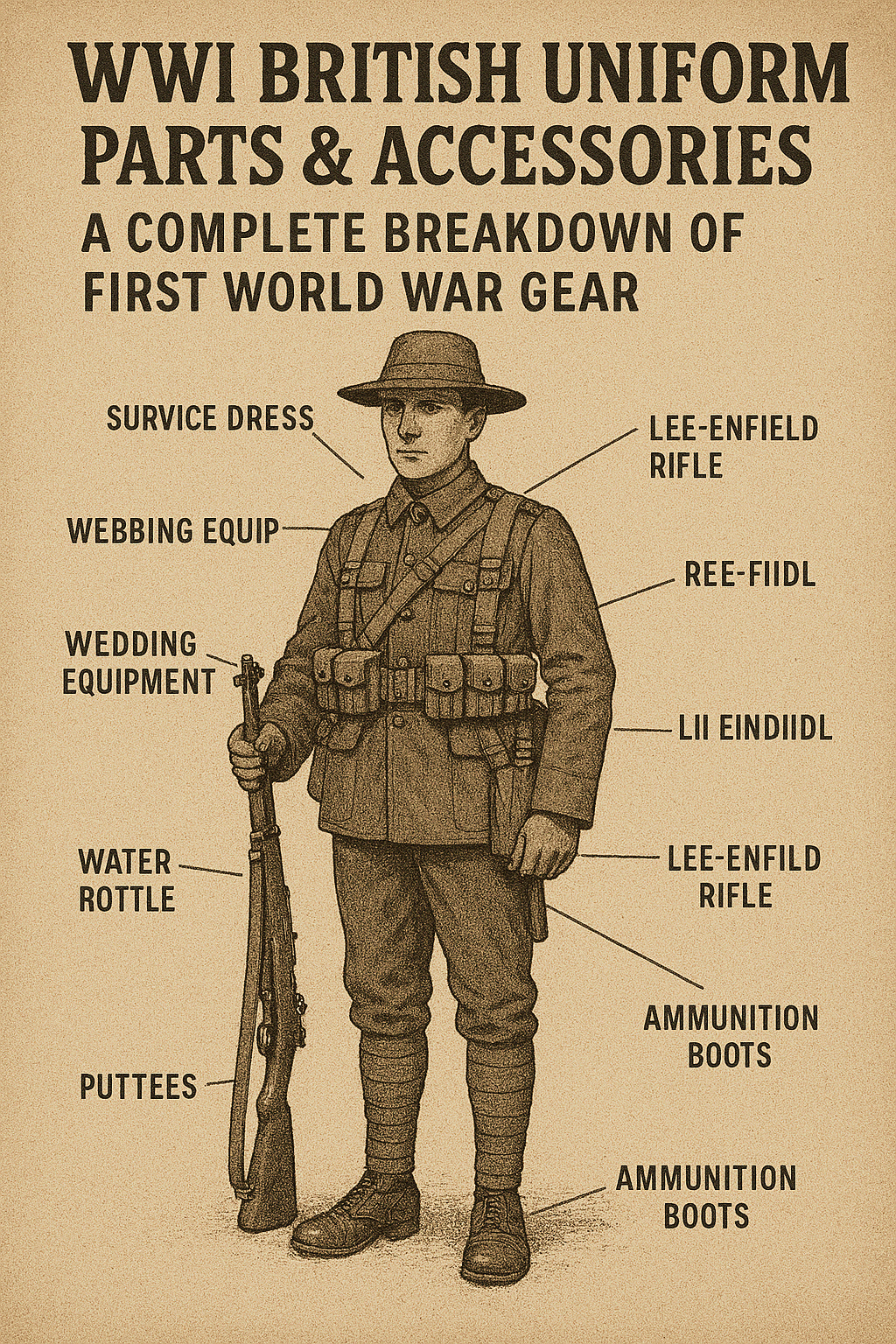
WWI British Uniform Parts & Accessories: A Complete Breakdown of First World War Gear
Published on Apr 15, 2025
WWI British Uniform Parts & Accessories: A Complete Breakdown of First World War Gear
introduction
The British Army ww1 during the First World War was not only defined by its soldiers' bravery but also by its distinctive and highly functional uniforms and accessories. From the muddy trenches of the Western Front to the scorching deserts of the Middle East, British troops were equipped with a variety of clothing and tools that evolved throughout the war. In this article, we’ll take a detailed look at the British uniform parts and accessories that shaped a soldier’s everyday existence during WWI.
1. The Foundation: British Service Dress
Introduced in the early 1900s, the British Service Dress was the backbone of military attire during WWI. The uniform was both practical and symbolic, consisting of:
- Wool Tunic (1902 Pattern): Made from khaki serge wool, this tunic featured pleated breast pockets and a high, stiff collar. It provided warmth and durability, which is crucial in trench warfare.
- Trousers: Typically constructed from the same khaki wool, these were worn tucked into puttees (leg wrappings) for extra warmth and protection.
- Puttees: Long woolen strips wound around the lower legs; puttees were essential for keeping out mud, water, and cold.
2. Iconic Headwear: The World War 1 Campaign Hat
One of the most recognizable pieces of the WWI British uniform was the World War 1 campaign hat, also known as the Brodie helmet (introduced in 1916). Before this, soldiers wore soft caps like the Service Cap, which offered no protection against shrapnel.
- Service Cap (Soft Cap): Used mainly in the early war years, this flat, round cap was more formal and offered no ballistic protection.
- Brodie Helmet: A steel helmet designed to protect from overhead shrapnel and debris. This helmet became synonymous with British soldiers by 1916 and remained in use well into WWII.
The switch to the Brodie helmet marked a turning point in military headgear, underscoring the brutal reality of trench warfare.
3. Field Gear and Accessories
No soldier went into battle without their essential gear. British troops carried a variety of items for survival, communication, and combat:
- Webbing Equipment: Known as the 1908 Pattern Web Equipment, it included:
- Ammunition pouches
- Water bottle
- Haversack for rations and personal items
- Entrenching tool
- Gas Mask: With the rise of chemical warfare, soldiers were issued early gas hoods, later replaced by the Small Box Respirator by 1916.
- Greatcoat: A heavy wool coat used in cold conditions, often carried on the back or slung over the shoulders.
- Mess Tin: A simple aluminum container used for eating rations.
- Bayonet Frog: Held the bayonet attached to a soldier’s rifle.
4. Weapons in the First World War
British soldiers were equipped with an array of weapons, each tailored for different combat situations. As the war progressed, weapons in the First World War evolved drastically due to the demands of trench combat.
- Lee-Enfield Rifle: The standard issue bolt-action rifle. Known for its reliability and 10-round magazine, it was the British Army’s workhorse.
- Bayonet: Often fixed to the end of the rifle for close-quarters combat.
- Grenades ("Mills Bombs"): The first modern fragmentation grenade adopted by the British Army.
- Machine Guns: Including the Vickers and Lewis guns, which revolutionized defensive warfare.
The changing nature of warfare also forced innovations in artillery and chemical weapons—details of which are explored on our ammunition evolution page.
5. Footwear & Protection
Surviving in trenches meant battling more than the enemy—cold, water, and disease were constant threats.
- Ammunition Boots: Durable leather boots with hobnails and iron heel plates to withstand rough terrain.
- Trench Foot Protection: Soldiers used whale oil on their feet to protect against trench foot, a condition caused by prolonged exposure to damp and unsanitary conditions.
- Puttees and Socks: Offered extra warmth and minor protection against minor wounds and leeches in flooded trenches.
6. Rank Insignia and Badges
Uniforms also served to display rank, regiment, and role. Soldiers wore:
- Shoulder Titles: Metal or cloth identifiers for a regiment or corps.
- Rank Chevrons: Sewn onto the sleeves of non-commissioned officers.
- Wound Stripes and Service Chevrons: Recognitions for combat injury or length of service.
7. Daily Use Accessories
Beyond battlefield gear, soldiers carried small personal items that made daily life a little more bearable:
- Ration Packs: Often tinned meat, hard biscuits, tea, and jam.
- Pocket Watches and Compasses: Essential for coordinating trench raids and patrols.
- Writing Kits: Many soldiers carried small journals or writing kits to send letters home.
8. Cold Weather and Desert Variants
While trench warfare in Europe dominates WWI imagery, British troops served globally:
- Tropical Uniforms: Lighter cotton fabrics for hot climates like the Middle East.
- Cold Weather Gear: Fur-lined gloves, scarves, and extra layers were issued for winter conditions on the Western Front.
Conclusion: The Evolution of the British Soldier's Kit
The uniform of the British soldier wasn’t just a set of clothes—it was a system built for survival, combat effectiveness, and endurance. Each component served a vital role, whether shielding from bullets, identifying comrades, or braving the elements.
Throughout the war, rapid changes in warfare—from chemical weapons to machine guns—meant that uniform and accessory design had to evolve quickly. Today, understanding these items gives us a deeper appreciation for the soldiers who wore them and the world-changing events they endured.
